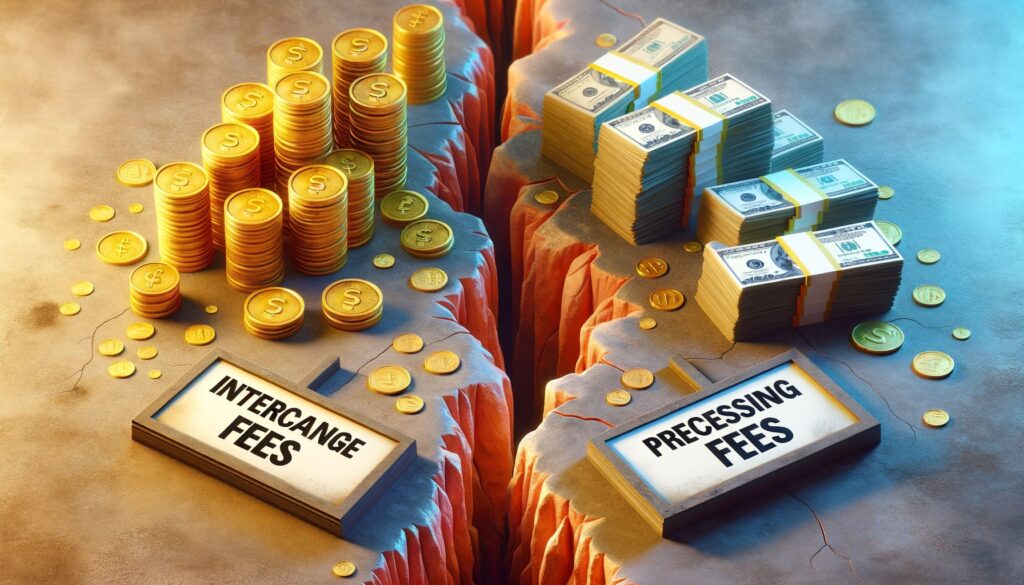Best Credit Card Processing Solutions Tailored for Every Industry

By admin October 15, 2024
In today’s digital age, financial transactions have become increasingly convenient and efficient. Whether it’s swiping a credit card at a local store or making an online purchase, payment card networks play a crucial role in facilitating these transactions. Behind the scenes, however, there is a complex system of fees and charges that enable these networks to function smoothly. One such fee that often goes unnoticed by consumers is the interchange rate.
Interchange rates are an integral part of the payment card industry, serving as a mechanism to compensate various stakeholders involved in the transaction process. Understanding how these fees work is essential for both merchants and consumers, as they can have a significant impact on the cost of doing business and the prices consumers pay for goods and services. In this comprehensive guide, we will delve into the intricacies of interchange fees, exploring their definition, purpose, calculation methods, and their impact on different parties involved.
What are Interchange Fees: Definition and Purpose
Interchange fees can be defined as fees charged by payment card networks to compensate card-issuing banks for the cost of processing transactions and assuming the risk associated with providing credit to cardholders. These fees are typically a percentage of the transaction value and are paid by the merchant’s acquiring bank to the card-issuing bank. The interchange rate is an essential component of the overall transaction cost, along with other fees such as processing fees and assessments.
The primary purpose of interchange rates is to incentivize card-issuing banks to issue payment cards and promote the growth and acceptance of these cards within the payment card network. By compensating banks for the costs and risks associated with providing credit, interchange fees ensure that card-issuing banks have the necessary financial incentive to participate in the payment card industry. This, in turn, allows consumers to enjoy the convenience and benefits of using payment cards for their transactions.
The Role of Interchange Fees in the Payment Card Industry

Interchange fees play a crucial role in maintaining the stability and efficiency of the payment card industry. They serve as a mechanism to balance the interests of various stakeholders involved in the transaction process, including card-issuing banks, acquiring banks, payment card networks, and merchants. Without interchange rates, the payment card industry would struggle to function effectively, leading to potential disruptions in the flow of funds and increased costs for all parties involved.
For card-issuing banks, interchange fees provide a vital source of revenue that helps offset the costs associated with issuing payment cards and managing the associated risks. These fees also incentivize banks to invest in the development and maintenance of payment card infrastructure, ensuring that consumers have access to a reliable and secure payment system.
Acquiring banks, on the other hand, benefit from interchange rates by receiving a portion of these fees as compensation for their role in facilitating the transaction process. This compensation helps cover the costs of providing payment processing services to merchants and maintaining the necessary infrastructure to support these services.
Payment card networks, such as Visa and Mastercard, also rely on interchange fees to fund their operations and invest in the development of new technologies and services. These networks act as intermediaries between card-issuing banks and acquiring banks, facilitating the authorization, clearing, and settlement of transactions. Interchange rates provide a significant portion of their revenue, allowing them to maintain and enhance the payment card infrastructure.
Merchants, although they bear the cost of interchange fees, benefit from the increased sales and customer convenience that payment cards offer. Accepting payment cards can attract more customers and streamline the checkout process, leading to higher transaction volumes and potentially increased revenue. However, the impact of interchange rates on merchants can vary depending on factors such as the industry, transaction volume, and negotiation power.
How Interchange Fees are Determined: Factors and Calculation Methods

The determination of interchange fees involves a complex process that takes into account various factors and considerations. Payment card networks, such as Visa and Mastercard, establish the interchange fee schedules and guidelines, which are then implemented by card-issuing banks and acquiring banks. The specific calculation methods and fee structures can vary between networks and regions, but they generally follow similar principles.
One of the primary factors that influence interchange rates is the type of payment card used for the transaction. Different types of cards, such as credit cards, debit cards, and prepaid cards, may have different interchange rate rates due to variations in the associated risks and costs. Credit cards, for example, typically have higher interchange fees compared to debit cards, reflecting the additional risk and credit-related services provided by card-issuing banks.
Another factor that affects interchange fees is the nature of the transaction itself. Transactions involving physical card-present payments, where the card is physically swiped or inserted into a terminal, generally have lower interchange rates compared to card-not-present transactions, such as online or phone-based purchases. This difference is primarily due to the higher risk of fraud associated with card-not-present transactions.
The volume and value of transactions also play a role in determining interchange fees. Higher transaction volumes and larger transaction values can result in lower interchange rates, as the economies of scale and reduced risk associated with larger transactions are taken into account. Conversely, smaller merchants or those with lower transaction volumes may face higher interchange fees due to the increased risk and costs associated with processing their transactions.
Interchange fees are typically calculated as a percentage of the transaction value, with a minimum fee threshold. For example, a common interchange fee structure may be 2% of the transaction value or $0.10, whichever is higher. This structure ensures that even small transactions generate a minimum fee to cover the costs associated with processing.
The Impact of Interchange Fees on Merchants and Consumers

Interchange fees can have a significant impact on both merchants and consumers, albeit in different ways. For merchants, interchange rates represent a cost of doing business that can affect their profitability and pricing strategies. These fees are typically passed on to merchants by acquiring banks, either as a separate line item or as part of the overall processing fees charged for payment card acceptance.
The impact of interchange fees on merchants can vary depending on several factors. Larger merchants with higher transaction volumes and stronger negotiating power may be able to secure lower interchange rates through direct negotiations with acquiring banks or payment card networks. Smaller merchants, on the other hand, may have less bargaining power and may face higher interchange fees, potentially impacting their profitability and pricing decisions.
For consumers, interchange fees indirectly affect the prices they pay for goods and services. Merchants often factor in the cost of interchange fees when setting their prices, as these fees contribute to their overall cost structure. Therefore, higher interchange fees can lead to higher prices for consumers, as merchants seek to recover these costs.
However, it is important to note that the impact of interchange fees on consumer prices is not always straightforward. The relationship between interchange rates and consumer prices can be influenced by various factors, including market competition, industry dynamics, and regulatory frameworks. In some cases, merchants may absorb a portion of the interchange fees to remain competitive, resulting in lower prices for consumers.
Interchange Fees vs. Processing Fees: Key Differences and Similarities

While interchange fees and processing fees are both components of the overall cost of accepting payment cards, they serve different purposes and are charged by different entities. Understanding the differences and similarities between these fees is essential for merchants and consumers to navigate the payment card landscape effectively.
Interchange fees, as mentioned earlier, are charged by payment card networks to compensate card-issuing banks for the costs and risks associated with providing credit to cardholders. These fees are typically a percentage of the transaction value and are paid by the merchant’s acquiring bank to the card-issuing bank. Interchange rates are standardized across the payment card network and are non-negotiable for individual merchants.
Processing fees, on the other hand, are charged by acquiring banks or payment processors for the services they provide in facilitating the transaction process. These fees cover the costs of authorizing, clearing, and settling transactions, as well as providing customer support and maintaining the necessary infrastructure. Processing fees can vary between acquiring banks and payment processors, and merchants often have the opportunity to negotiate these fees based on their transaction volume and other factors.
Despite these differences, interchange fees and processing fees are interconnected and contribute to the overall cost of accepting payment cards. Acquiring banks typically bundle these fees together and charge them to merchants as part of the overall processing fees. This bundling can make it challenging for merchants to differentiate between interchange fees and processing fees when analyzing their cost structure.
Interchange Fee Structures in Different Payment Networks: Visa, Mastercard, and Others

Interchange fee structures can vary between payment card networks, with each network having its own set of rules and guidelines. Two of the most prominent payment card networks, Visa and Mastercard, have established interchange fee schedules that are widely used around the world. Understanding the interchange fee structures of these networks can provide insights into the broader landscape of interchange rates.
Visa’s interchange fee structure consists of different categories, each with its own fee rates and criteria. These categories include credit cards, debit cards, prepaid cards, and commercial cards. Within each category, there are further differentiations based on factors such as the type of merchant, transaction volume, and transaction value. Visa’s interchange fees are typically calculated as a percentage of the transaction value, with a minimum fee threshold.
Mastercard’s interchange fee structure follows a similar approach, with different categories and fee rates based on factors such as the type of card and the nature of the transaction. Mastercard also considers additional factors such as the merchant’s industry and transaction volume when determining interchange rates. Like Visa, Mastercard’s interchange fees are typically calculated as a percentage of the transaction value, with a minimum fee threshold.
Other payment card networks, such as American Express and Discover, also have their own interchange fee structures. These networks often operate on a closed-loop system, where they issue their own payment cards and handle both the issuing and acquiring functions. As a result, their interchange fee structures may differ from those of open-loop networks like Visa and Mastercard.
Interchange Fee Regulations and Legal Frameworks: A Global Perspective

Given the significant impact of interchange fees on merchants and consumers, regulatory bodies around the world have implemented various measures to ensure fairness and transparency in the payment card industry. These regulations aim to strike a balance between the interests of different stakeholders and promote competition and innovation within the industry.
In the United States, for example, the Durbin Amendment, part of the Dodd-Frank Wall Street Reform and Consumer Protection Act, introduced regulations on debit card interchange fees. The amendment capped the interchange rates for debit card transactions issued by large banks, aiming to reduce costs for merchants and ultimately benefit consumers. However, smaller banks and credit unions were exempted from these regulations, leading to a complex landscape of interchange fees for debit card transactions.
In the European Union, interchange fees have been subject to regulation under the Payment Services Directive (PSD) and the Interchange Fee Regulation (IFR). These regulations aim to promote transparency and competition in the payment card industry, setting maximum interchange fee rates for both credit and debit card transactions. The IFR also introduced rules on the separation of payment card schemes and processing entities to enhance competition and innovation.
Similar regulatory frameworks exist in other regions, such as Australia, Canada, and Brazil, where interchange rates have been subject to scrutiny and regulation. These regulations often focus on promoting transparency, competition, and consumer protection, while also considering the interests of card-issuing banks and payment card networks.
Common Misconceptions and Myths about Interchange Fees
Interchange fees have been a subject of debate and controversy, leading to various misconceptions and myths surrounding their nature and impact. It is essential to address these misconceptions to foster a better understanding of interchange rates and their role in the payment card industry.
Misconception 1: All Merchants Pay the Same Interchange Fees
In reality, interchange fees vary based on several factors, including transaction type, card type, and merchant category. Each merchant may have a unique fee structure tailored to their specific circumstances.
Misconception 2: Merchants Set Interchange Fees
Interchange fees are established by card networks and are non-negotiable for merchants. However, businesses can choose payment processors that offer more favorable pricing structures.
Misconception 3: Higher Interchange Fees Always Benefit Consumers
While higher interchange fees may fund consumer rewards programs, they can also result in increased prices for goods and services. Consumers may not always directly benefit from higher fees if merchants pass those costs onto them.
FAQs
Q1. What is the average interchange fee?
The average interchange fee can vary widely based on transaction type and card networks. Generally, interchange fees range from 1.5% to 3.5% of the transaction amount, plus a flat fee (typically $0.10 to $0.30).
Q2. Can merchants negotiate interchange fees?
Merchants cannot negotiate interchange fees directly since they are set by card networks. However, they can select payment processors that provide better overall pricing and lower fees.
Q3. How do interchange fees affect small businesses?
Interchange fees can significantly impact small businesses, as these fees may represent a larger portion of their operating costs. Small businesses should carefully evaluate their payment processing options to minimize fees.
Q4. Are interchange fees the same for credit and debit cards?
No, interchange fees are generally higher for credit cards than for debit cards due to the increased risks associated with credit transactions, such as potential defaults.
Q5. How can businesses reduce interchange fees?
Businesses can reduce interchange fees by choosing payment processors with favorable pricing structures, encouraging the use of debit cards, and optimizing transaction types to minimize costs.
Conclusion
Interchange fees are a fundamental component of the payment card industry, serving as a mechanism to compensate card-issuing banks for the costs and risks associated with providing credit to cardholders. These fees play a crucial role in maintaining the stability and efficiency of the payment card ecosystem, balancing the interests of various stakeholders involved in the transaction process.
Understanding how interchange rates work is essential for both merchants and consumers, as they can have a significant impact on the cost of doing business and the prices consumers pay for goods and services. By delving into the intricacies of interchange fees, including their definition, purpose, calculation methods, and their impact on different parties involved, this comprehensive guide has provided a comprehensive overview of this important aspect of financial transactions.
While interchange fees can be complex and subject to regulation, they ultimately contribute to the growth and accessibility of the payment card industry. By compensating card-issuing banks for their services and risks, interchange rates enable consumers to enjoy the convenience and benefits of using payment cards for their transactions. As the payment card landscape continues to evolve, understanding interchange fees will remain crucial for all participants in the financial ecosystem.
